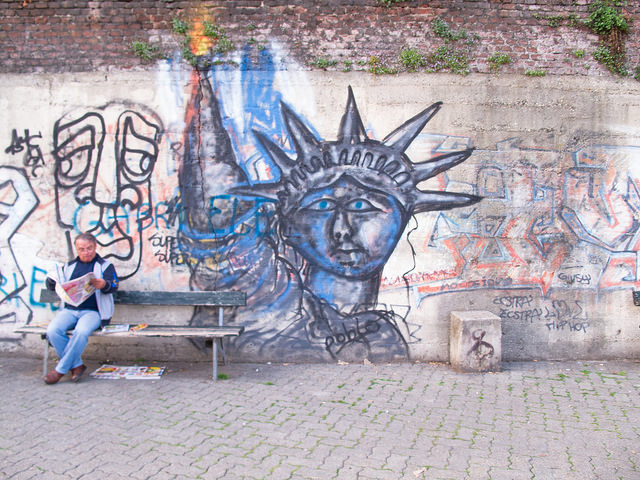Today is the 130th anniversary of the Statue of Liberty’s arrival in New York Harbor. To celebrate, Google has offered up one of its “doodles”, in which a disproportionately huge rendering of the bronze lady dwarfs the ship that is bringing her to the United States. She appears to be tipping over, as if she were about to fall into the sea. It’s a strangely resonant image.
For one thing, the story it tells differs from what most contemporary visitors expect. Although the parts for the statue landed on June 17th, 1885, it wasn’t assembled into the free-standing icon known around the world until a good deal later. Already an engineering marvel — a French team had been working on the statue since the gift was announced during the United States’ Centennial in 1876 — the statue was nevertheless more fantasy than reality when she arrived, no more whole than the ancient Colossus of Rhodes.
The idea that the French government had completed the statue before shipping her identifies her strongly with the Old World. So does the bow around her waste featuring the tricolor motif of the French flag. This shift of emphasis may be intentional on Google’s part. The company’s statement about the doodle calls the statue, “one of the most prolific symbols of freedom the world over. Since then, it has welcomed millions of people searching for a new life on unfamiliar shores,” adding that, “today, the Statue of Liberty is more than just a symbol of solidarity. It’s a reminder that all countries thrive on the exchange of ideas and culture.”
While this description isn’t wrong, exactly, it is curiously decontextualized. Maybe the authors just take it for granted that it is impossible to muse on this icon without simultaneously thinking of the United States. Yet there’s no denying that the language they use works very hard to conjure a Lady Liberty that transcends both her French birthplace and her American home. At the very least, it’s a nod to the conviction that freedom these days increasingly seems to be found, if it is found at all, in spaces that do not readily align with nineteenth-century conceptions of nationhood.
Although both the doodle and its description may be innocent of self-consciously ideological maneuvering, it is also impossible to overlook the fact that this account of liberty is compatible with Google’s self-interest as a transnational corporation that profits from “the exchange of ideas and culture” like few others. A pessimist might well conclude that the image of the statue being shipped actually has more to tell us about its future than its past. If London Bridge can be rebuilt brick by brick in the Arizona desert, Lady Liberty can be sold off to private investors as well.
Even if that isn’t likely to happen in a literal sense, it can be convincingly argued that the process is already underway at the level of metaphor. Ask most people around the world whether they still see the United States as a land of liberty, where the possibilities are limitless, and you are no longer likely to receive an unqualified “Yes” in response. Sure, almost everyone knows of someone who emigrated to the United States and created a new and more successful life for her or his family. But such tales of the American Dream are increasingly pitted against ones in which the nation’s government is positioned as the primary antagonist that liberty must contend with.
Although someone like Edward Snowden may seem quintessentially American in many ways, his political identity is perceived as decidedly post-national. The warning he helped to give the world about just how thoroughly liberty is being compromised in the name of security radically undercuts the belief that it is possible to be more free in the United States than in other places. Indeed, the fact that he is living in the heart of the former Soviet Union speaks volumes about the dissociation of personal liberty from the idea of America. Few would claim that Vladimir Putin’s Russia should truly be considered a champion of freedom. Yet it has served that way for Snowden, however provisionally.
That said, it’s hard to imagine many people believing that the Lady Liberty in Google’s doodle is being carted off to Moscow or Beijing. Far more likely is that the statue’s destination is one of those “private-public” spaces where a corporation holds sway. That, after all, is the Neo-Liberal Dream, one which Google, like most large companies, enthusiastically endorses. For them, “limitless possibilities” are a propagandistic label for the removal of barriers to trade, whether through the elimination of tariffs, the dismantling of national and international judicial structures, or the frustration of governments’ efforts to censor the flow of information.
It’s worth asking, though, whether the Statue of Liberty, for all of its ideological baggage, might not be repurposed as an icon of personal freedom in opposition to both the nation state and the Neo-Liberal fantasies of transnational corporations like Google. The bronze lady may look ill in the graffiti documented in the lead image for this piece, but she also sports a “free-hand” liveliness that transcends whatever critique the image’s creator was intending to make. No matter how much people around the world may have soured on the traditional American Dream, they still want to believe in a place where a “mighty woman with a torch” extends “world-wide welcome” as the “Mother of Exiles.”
Emma Lazarus’s famous poem, inscribed on a plaque at the base of the statue, defies any dilution into the rhetoric of free trade. Her Lady Liberty is not “a reminder that all countries thrive on the exchange of ideas and culture,” but a call to counter the pernicious effects of trade without conscience: “Give me your tired, your poor, your huddled masses yearning to breathe free, the wretched refuse of your teeming shore. Send these, the homeless, tempest-tost to me.” Perhaps, stripped of her nationality, the great icon can be made to stand instead for an internationalism that repudiates the heartless logic of the marketplace.
Photograph courtesy of Joel Schalit.





